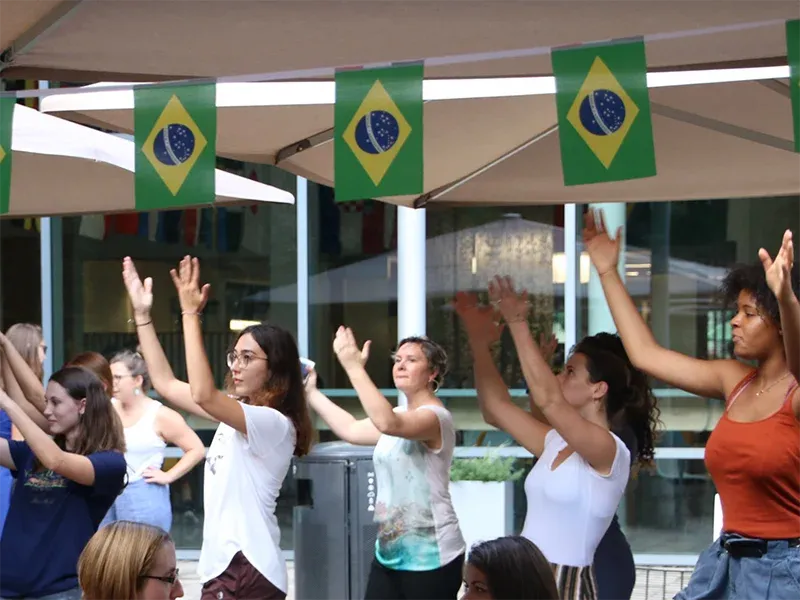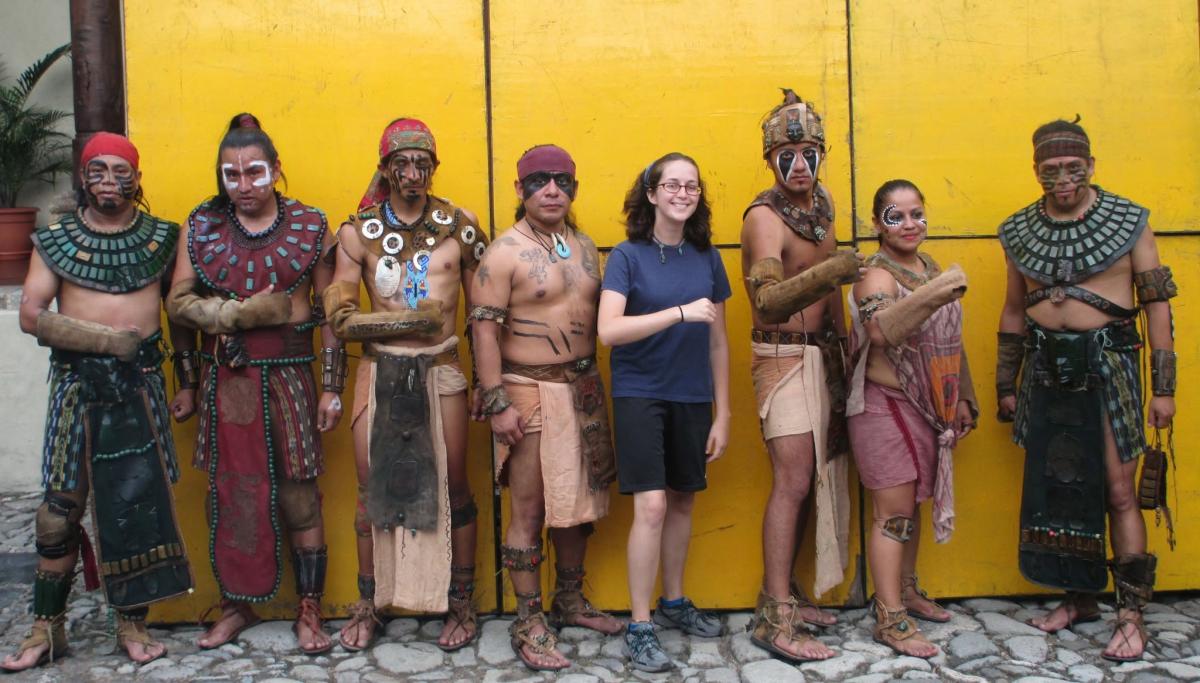
In the School of Liberal Arts, a dozen languages are offered across various disciplines and programs. From Spanish and Arabic, to Vietnamese and Swahili, the types of languages range from those spoken widely across the globe to regional and even dormant languages. Faculty throughout the school are exploring not only what it means to teach a language that students can speak, write, and hear, but they are also interrogating the implications of learning a language other than the ones students grew up speaking.
Learning languages other than the one we are taught from birth provides a greater perspective of the world around us. Many argue that learning a second or third language prepares students for conversations that cross geographic and social boundaries, and makes space for them to learn more about themselves as they learn about others. Some languages require the student to adapt to a new organizational structure vastly different from how she or he may have written or read a sentence in their native tongue, while others require an even greater understanding of a history and culture. For students beginning their education at Tulane in 2018, a revised core curriculum requires proficiency in a second language to support the university’s goal to prepare the students for a global world. So how does learning a new language contribute to the idea of a global education?
Professor of Arabic Bouchaib Gadir believes “a global education continues to subsist outside of the classroom as a means of assimilating culture and humanity to make the world a better place. Global education encourages students to learn more than just language as language, but instead as an experience embedded in culture. Learning a language is acquiring a new identity, which allows students to better understand the world.” From learning about food, music, and everyday life, to creating dictionaries for sleeping languages, how professors and scholars across the School of Liberal Arts approach teaching varies widely, but each embraces the discipline with their own remarkable methodology.
SCAFFOLDING
As an anthropologist and ethnographer, Megwen Loveless, a School of Liberal Arts professor of Portuguese, is dedicated to bringing culture into the classroom. Tulane students enrolled in Loveless’ Portuguese classes participate in a Telecollaboration program during which her students speak one-on-one with students in Brazil via Skype for an hour each week, beginning as early as the first week of class. Spending thirty minutes speaking in Portuguese and thirty minutes in English, the students utilize new and established vocabulary to talk about everything from food to what they’re watching on Netflix. As Loveless explains, “what they end up learning is that a day-to-day lifestyle in Brazil is not actually all that different from here; instead, they learn about nuances of culture that you might not learn otherwise.”
Telecollaboration is just one way Loveless employs a scolding methodology and the “i + 1” method in her Portuguese classes. “While you start at ground zero,” she says, “you slowly build on vocabulary and grammar, but always push the students just a bit further than they might be comfortable.” For example, while the English-speaking students prepare a short biography to introduce themselves to the Brazilian students via Skype, they usually are left with another fifteen minutes to fill with conversation in Portuguese. The students begin engaging with YouTube, Google Translate, and a variety of other online tools and resources to keep the conversation going as they practice speaking in Portuguese and English while learning more about each other’s culture.
Loveless also plays a song in Portuguese each day in class to give the students an opportunity to learn about music while practicing their vocabulary and conjugations. To try and break down more boundaries within the teacher-student relationship and to engage more native-Portuguese speakers in the region, she also organizes events in the afternoons called Baté Papo, during which individuals share Brazilian desserts and speak casually. “The first thing I tell students is that we are not going to learn how to speak, we are going to speak to learn,” said Loveless.
TOTAL IMMERSION
Judith Maxwell, a professor in the Department of Anthropology who teaches indigenous languages such as Tunica and Kaqchikel, spoken in Louisiana and Guatemala, respectively, practices total immersion in the classroom and in the community. Similar to Loveless’ scaffolding approach, Maxwell uses tools like storytelling in her total immersion methodology to build the students’ vocabulary in a new language. For example, when she works with young people in the Tunica-Biloxi Tribe in southern Louisiana—the majority of whom do not know the indigenous language—she begins by telling a story in the Tunica language. Then she and her team ask a series of questions in Tunica to see that the students understand what they’re saying through non-verbal responses or body language. Next, they move on to yes/no questions for the students, and eventually ask questions that require them to answer with existing vocabulary, then new vocabulary. In essence, the student hears the language five times before they are asked to speak it. Guatemala’s Universidad Rafael Landívar and Maya Wuj—a publishing house run by Kaqchikel entrepreneurs—have published Maxwell’s immersion teaching methodology, and she also teaches it to her students and other language teachers. Because of her work with students at Tulane and in the Tunica-Biloxi community, the Tunica language, which was once a “sleeping language,” is now registered as “reawakening” by the language database Ethnologue. Between 1948 and 2010 the Tunica language had no recorded speakers; however, today, 85 tribal members and 52 affiliates speak Tunica.
A sleeping language is one that no longer has native speakers, but still has a heritage community that identifies with the language and the culture it encodes.

Maxwell’s scholarship and teaching also delves into the important work of understanding the relationship between language, power, and identity. In her course “Language Death and Revitalization,” Maxwell begins by “talking about the pressures that have led to the disappearances of languages and the kinds of consequences for heritage communities and the wider world communities.” Students study languages that the UNESCO, WorldCat, and Ethnologue databases rate as vulnerable or below on the endangerment scale, researching the language’s writing and speaking system, the communities in which the language is used, and what is being done to strengthen and save the language. For her work in Tunica, this also means reviving important cultural and historical practices such as the game of stickball and basket weaving techniques, as well as developing the language and vocabulary used for those activities. Similarly, Maxwell’s class works with the youth to build new vocabulary that wasn’t needed before the language began to fade. Students create words for computers and technology and get credited in their ever-evolving dictionary. As Maxwell states, “it’s important to see language beyond being purely instrumental. Learning more languages widens horizons. Doing so requires a shift in your basic intellectual mechanisms because you gain a different idea of what constitutes truth, a different idea of how reasoning takes place, a different idea of how the world is broken up into pieces, and a different idea of how people interact with the world and each other.”
COMMUNICATION-ORIENTED
For Gadir, an all-inclusive approach allows students to gain a more holistic understanding of a language rather than learning one component of a language at a time. As Gadir describes, “unlike the traditional method in teaching language, which teaches the grammar of the target language in segments and blocks, my method seeks to teach the language as a ‘whole,’ developing four skills simultaneously in students—listening, speaking, reading, and writing.” Communication-oriented teaching allows him to focus on the teacher-student relationship and adjust his syllabus throughout the semester to meet students’ needs. Gadir teaches functional Modern Standard Arabic (MSA) in which he presents grammar through context, using supportive materials such as short stories, advertisements, newspaper articles, and inviting native speakers to class.
Global education encourages students to learn more than just language as language, but instead as an experience embedded in culture.
Gadir often screens films for his students as a tool for them to engage with important historical, cultural, and political issues. By tying language to Arabic culture, he aims for each student to gain an understanding of the customs, forms of address, hospitality, table manners, dress code, ceremonies such as marriage, Arabic music, and Islamic holidays such as Ramadan. “The advantage of this is that it shows how religiously plural the Arab world is,” Gadir explains.
Whether through films, storytelling, or Skype, Gadir, Maxwell, and Loveless each offer teaching methodologies that ask liberal arts students to broaden their approach to learning a new language. A global education—or, as Loveless would say, an education—“is all about opening doors and opening minds. We have to keep working to open these doors to become responsible citizens in this globalized world, and I think the only way past our current moment of tension is to learn more and increase our ability to communicate across barriers.”

